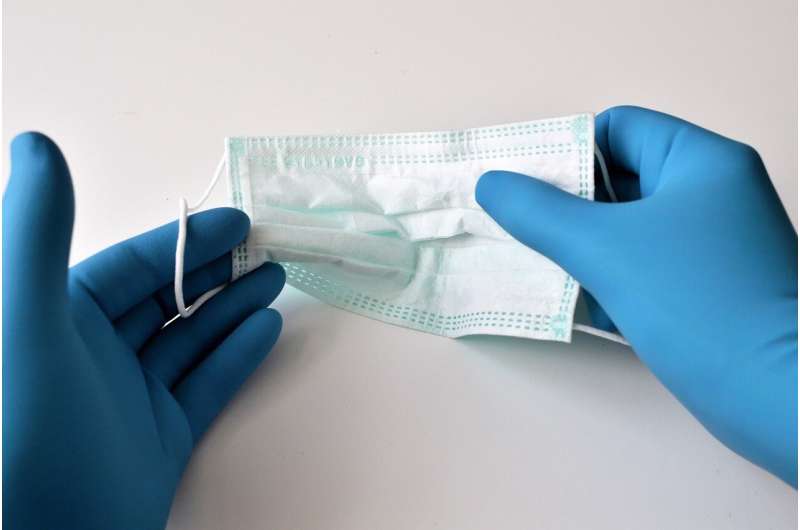Credit: CC0 Public Domain
Before COVID-19, there were around 10,000 deaths in care homes in England and Wales every month. Then, between March 27 and April 24 2020, the number more than doubled to 23,113.
The Office for National Statistics (ONS) later reported 17,422 deaths of care home residents from COVID-19 between the end of March and June 5, accounting for 47% of the total number of deaths caused by the virus.
So it is unsurprising that the pandemic has led to much greater interest in what happens inside care homes. As well as the significant increase in the number of residents dying, concerns have been raised about a lack of access to testing and personal protective equipment (PPE), the discharge of coronavirus-positive patients from hospital to care homes, rationalisation of the health care received, and a lack of clarity about the numbers of residents dying from COVID-19.
Even before the pandemic, the private ownership of most care home establishments isolated them from accessing appropriate training and support from NHS professionals, such as specialist nurses and palliative care teams. Some members of the care home sector have since called for doctors and nurses to be deployed to care homes to help manage the crisis.
Care home staffing is also a challenge, with vacancy rates of 11% and a workforce that is ageing, low paid and reliant on immigration. This is coupled with the knock-on effects of shrinking local government adult social care budgets, meaning that the care home market is increasingly fragile.
For my recent research, I spoke with residents of care homes about their experiences of living—and the prospect of dying—in them.
Many said they had disagreed with the decision to move into a care home, but their views were not listened to or considered. Despite paying up to £4,000 per month to do so, living in this environment is often associated with imposed routines and a loss of control and independence.
Despite this, some people I spoke to did have positive things to say. There was the 94-year-old man who clearly valued the efforts of the staff who care for him. He told me: "They sit on the bed and they have a good old natter and a laugh too, which is the best medicine. They pinch my sweets. But yes, we have a good laugh. This is a very happy place, actually."
One 86-year-old woman, weighing up the pros and cons of where she received her care, explained: "At the moment I prefer care home to hospital because I feel perhaps a hospital is a bit impersonal—but on the other hand they tend to you quicker. But I wouldn't like to be in a hospital now. The last time I [was] there I was thinking [the] care home would be more comfortable."
Those residents will have seen major changes in the homes they live in over the last few months, with visits heavily restricted and staff wearing masks. GPs also switched to remote consultations, by telephone or video, which will also have affected the experience of some residents—such as planning for care at the end of life.
Important conversations
As a GP, I have seen firsthand the difference it can make if care home residents and their families have the opportunity to have important conversations about their wishes and preferences for care at the end of life. Not everyone is keen, of course. Asked whether or not she discussed death and dying with her family, one 96-year-old woman told me: "No, I don't speak [about death]. I'm not a person like that. I think my daughter knows me, she knows how I feel about things."
Unfortunately, some organisations appear to have dispensed with a personal approach to these conversations since the pandemic. One GP surgery sent letters to vulnerable patients stating that they would like to complete DNACPR (do not attempt cardio-pulmonary resuscitation) forms on their behalf. Brighton and Hove Clinical Commissioning Group also wrote to all GP practices suggesting that all residents of the 98 care homes in that area should have a resuscitation plan in place.
On this particular issue, more open discussion is required about the reality of resuscitation following a cardiac arrest. This should include the fact that all cardiac arrests have an underlying cause and that resuscitation attempts will only be successful if this cause can be identified and reversed.
The underlying cause of cardiac arrests in older, more frail people is usually due to a range of factors and rarely easily reversible. The chance of them surviving a resuscitation attempt is very low.
Resuscitation, involving electric shocks to the heart and chest compressions, can be a brutal process, and not what most people would describe as a "good death". It can be helpful to think about not attempting to resuscitate as allowing the natural process of death to occur peacefully and with dignity.
Peace and dignity are surely the things we would wish for anyone nearing the end of their lives. Yet our most vulnerable members of society have suffered greatly during this pandemic.
Care homes have long been neglected, partly due to widespread privatisation and low levels of funding for social care. We should all hope that the coronavirus crisis marks a turning point—and a change that means care homes are finally given the funding, staffing and support they so desperately need.
Provided by The Conversation
This article is republished from The Conversation under a Creative Commons license. Read the original article.![]()























